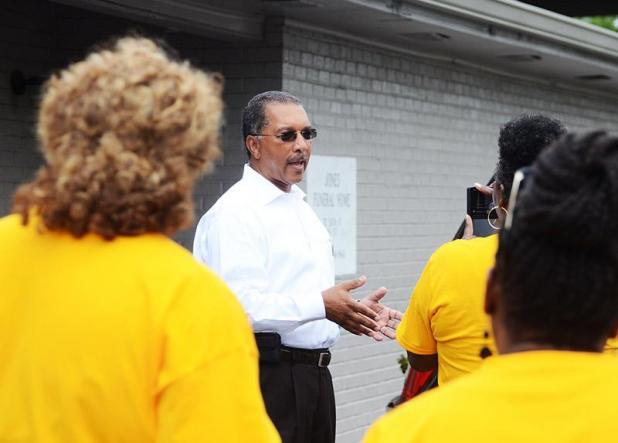
The Daily Review/Geoff Stoute
Byron Jones of Jones Funeral Home in Morgan City speaks about his business while visitors listen during Saturday’s Juneteenth Community Bike Ride in Morgan City.
From the Editor: St. Mary's place in the abolition of slavery
Saturday’s observance of Juneteenth in Morgan City brought to mind St. Mary Parish’s complicated role in the abolition of slavery.
St. Martin, Assumption and a handful of other south Louisiana parishes played the same role.
The script for this role is written in dense legalese, which doesn’t seem to have changed much in a century and a half. But it’s part of a story about promises made, promises broke and promises redeemed.
The legalese is in the Emancipation Proclamation, signed by President Abraham Lincoln on Jan. 1, 1863, months before Gettysburg, Vicksburg and Port Hudson. The proclamation meant nothing, in one way, but it also meant everything.
Lincoln based his proclamation on his powers as commander in chief of a country at war. It freed enslaved people in areas of the nation — the federal government didn’t recognize the Confederacy as a separate country — in open rebellion.
Some argue, and they make sense, that the proclamation made no one free as a practical matter. Even aside from areas held by Confederates, it didn’t apply to four slave states that didn’t secede, nor to the Virginia counties that broke away and would become West Virginia.
Meanwhile, as Union troops fumbled their way through the early Civil War years in the East, the federals in the West met with more success. Their efforts were directed at controlling the Mississippi River and its tributaries and were mostly successful, thanks to soldiers such as Gen. Ulysses Grant, Gen. William Sherman and a private in the 10th Missouri Cavalry named Welcome Decker. He was my great-great-grandfather.
By 1863, the lower Atchafalaya River was in Union hands.
So there was no active rebellion. St. Mary, St. Martin and Assumption were among 13 parishes specifically exempted from the terms of the Emancipation Proclamation.
Even though emancipation remained more of a goal than a reality for two years, the proclamation made it clear that Union victory — far from a sure thing in 1863 — would mean abolition.
That happened with passage of the 13th Amendment. Juneteenth, or June 19, marks the anniversary of the day in 1865 when enslaved people in Texas were officially freed.
Again, the argument can be made that the story was far from over at that point.
Reconstruction in Louisiana was a bloody business. Massacres of African American people occurred in Thibodaux, New Orleans, Opelousas and, maybe most significant of all, in Colfax.
More than 100 black soldiers were killed in Colfax after the end of a brief battle in 1872, near where the city’s library stands today. A federal prosecutor’s relentless efforts to bring the killers to justice resulted in a landmark Supreme Court decision.
That decision, Cruikshank v. United States, said the Bill of Rights and the newly enacted 14th Amendment applied only to federal government actions, not to those of states or private individuals.
And that made possible all the Jim Crow laws that would grip the South until the civil rights legislation of the 1950s and 1960s.
As Martin Luther King Jr. said, the arc of history is long. But it bends toward justice.
Bill Decker is managing editor of The Daily Review.
